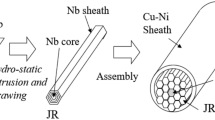Abstract
One of the reasons why high critical current density is difficult to achieve in fine filament Nb-Ti superconducting wire is that a reaction occurs between the copper matrix and Nb-Ti filaments. A diffusion barrier around each filament was introduced in the processing of fine filamentary wire in order to achieve Jc values close to the intrinsic ones.1 One study of diffusional reaction rates through the Nb barrier2 has indicated that, for typical SSC composites, a barrier area of 4% and 9% is necessary for producing Oμm and 2.5μm diameter filaments respectively. Consequently, if diffusional interactions can be eliminated without adding a large volume of barrier material, it is possible to achieve higher Jc’s at lower cost. Another limitation on the Jc in fine filament Nb-Ti superconducting wire results from the mismatch in mechanical properties of Nb-Ti filaments and copper matrix at high wire strains. The hardness and ultimate tensile strength (UTS) of Nb-Ti filaments increase with increasing amount of the cold work and no UTS saturation has been seen3, whereas the UTS of copper saturates. An improper filament array also adversely affects Jc, but this can be resolved by changing the filament distribution geometry, i.e. by reducing the interfilamentary spacing.4 Improving mechanical strength of copper matrix is important for reducing the amount of fine filament sausaging. Recently, in work that was primarily directed towards the development of material for ac applications, it was reported that, when silicon is added to the copper matrix, the formation of intermetallic compounds can be greatly reduced5,6. Cu-Si alloy also has mechanical properties more compatible with NbTi than copper. If the above results can be verified, the technique can probably be applied to the manufacture of high Jc SSC type conductors and large filamentary NbTi superconductor materials for general use. The work described here was to investigate these effects of silicon additions to the Cu matrix.
Access this chapter
Tax calculation will be finalised at checkout
Purchases are for personal use only
Preview
Unable to display preview. Download preview PDF.
Similar content being viewed by others
References
T.S. Kreilick, E. Gregory, and J. Wong, “Fine Filamentary NbTi Superconducting Wires”, Adv. in Cryo Eng.,A.F. Clark & R.P. Clark, 32 pp 739–745, (1986).
K.J. Faase, P.J. Lee, J.C. McKinnell, and D.C. Larbalestier, “Diffusional Reaction Rates Through the Nb Wrap In SSC and Other Advanced Multifilamentary Nb46.5wt.%Ti Composites,” Adv. in Cryo Eng., 38B:723 (1991).
Z. Guo, and W.H. Warnes, “Mechanical Behavior of Fine Filament Nb-Ti as a Function of Processing,” IEEE Trens actions on Applied Superconductivity, 3,1: 1022, (1993).
E. Gregory, H. Liu, G.M. Ozeryansky, M.D. Sumption, K.R. Marken Jr., and E.W. Collings, “Experiments To Improve Materials For SSC Magnets,” “Supercollider 4,” John Nonte, ed., Springer Science+Business Media New York, pp.923–930, (1992).
K. Tachikawa, J. Ninomiya, T.Ajioka, M. Terada, and K. Sakinada, “Recent Studies On Composite Superconductors,” 7th U.S.-Japan Workshop on High Field Superconductors, Fukuoka, Japan, Oct. 22-24, 1991.
S. Akita, S. Torii, H. Kasahara, K. Matsumoto, Y. Tanaka, T. Ajioka, and K. Tachikawa, “Ultrafine Multifilamentary Nb-Ti Wires with Cu-Si Alloy Matrix,” Cryogenics, 33, 2:199 (1993).
J.M. Seuntjens, SSCL, Private communication.
H. Kanithi, P. Valaris, and B.A. Zeitlin, “A Novel Approach to Make Fine Filament Superconductors,” “Supercollider 4,” John Nonte, ed., Springer Science+Business Media New York, pp. 41–47, (1992).
Author information
Authors and Affiliations
Editor information
Editors and Affiliations
Rights and permissions
Copyright information
© 1994 Springer Science+Business Media New York
About this chapter
Cite this chapter
Liu, H., Faase, K.J., Gregory, E., Zeitlin, B.A. (1994). The Effect of Silicon Addition to The Interfilamentary Copper on JC, Compound Formation and Interdiffusion. In: Hale, P. (eds) Supercollider 5. Springer, Boston, MA. https://doi.org/10.1007/978-1-4615-2439-7_138
Download citation
DOI: https://doi.org/10.1007/978-1-4615-2439-7_138
Publisher Name: Springer, Boston, MA
Print ISBN: 978-1-4613-6036-0
Online ISBN: 978-1-4615-2439-7
eBook Packages: Springer Book Archive




